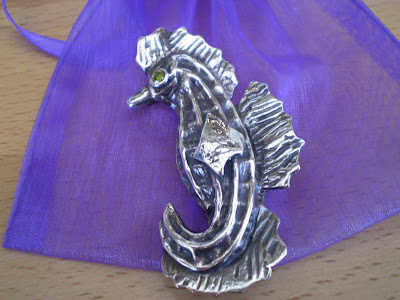I was really looking forward to working with the sterling silver clay that Mitsubushi were developing.
I waited for it to come on sale and In the mean time I followed all the jewellery designers that were working with it before it came on sale for the rest of us.
I usually work with Art Clay so I knew this new clay would be quite different.
I already had a few designs in mind the first one was a pendant, the design I had in mind needed to be in relief, I tried a few ways of making a mould but I wasn't happy with the results.
I had recently read about a technique called water etching, which looked like it could be the way to go.
This design will have three "firsts" for me:-
1. the clay.
2. water etching.
3. hinges.
The pendant was going to be a beetle with a design on its back
(the pendants front).
I wanted the pendant to have a front and back joined by a hinge.
After buying the clay it took me a while to get around to starting, I made a template for the shape of the front, textured one side and dried it texture side down, on the top of a light bulb to get a domed shape.
When it was dry I refined and smoothed the shape using sanding pads, the design was drawn on the clay in pencil.
I used nail varnish as a resist, and using a fine brush painted over the pencil lines, after leaving the varnish to dry thoroughly and taking a slightly damp natural sponge I rubbed away the clay in between the nail varnish lines.
The drilled hole was for a design idea that didn't work.
when it was dry I created a shape for the back of the pendant, textured it both sides and dried it flat.

The next step was the hinges, using a clay extruder and the round holed disc I extruded a length of clay about 5cm. long, when the clay was leather hard I cut 0.5cm discs and pushed a needle through the centre of each disc as a guide hole for the drill later on.
Once I had refined each component it was time to put it together, as the sterling silver clay is stronger than silver clay it can be rolled out thinner, and it is quite flexible in its dry state, which worked in my favour with the back, as it needed to be manipulated a little.
I had decided to put a loop on the back of the front piece, then a slot in the back piece to fit over the loop (fingers were crossed at this point).
I wasn't sure were to put the hinge, this bit was guess work, I put two discs on the front, one on the back. It took a lot of putting them on and taking them off again before I got it right, once they were dry I drilled through the three pieces.
I also added oak leaves to the front of the back piece. Once everything was dry I fired all the pieces following the instructions that came with the clay, which is in two stages, first they were put into a cold kiln at 538c for 40mins. after letting them cool for a while, they were put into activated carbon in a stainless steel container at 815c for 2 hrs.the firing times are slightly longer than the instructions state but I always leave art clay in for that length of time.
When I took them out the clay had blistered quite badly, mainly on the undersides.
I didn't take photo's at that stage, I don't know why but I had pondered on what I could do about it and couldn't wait to get the blisters knocked out, this partially worked and left a bit of scarring luckily most of this is in the inside, and this piece is a test piece and not going to be sold.
I wanted to find out why this happened so got in touch with The PMC Guild, the answer was they didn't know either. Apparently this happens very rarely and they are trying to find out the reasons and rectify it. And they have promised that they will replace the clay, which is very fair.
With a little bit of jiggling and knocking about the pieces were put together.
I used Liver of Sulphur to colour the silver, polished the raised areas so the design was bolder, plus I love to patina silver you never know what the colour result will be.
The antennae are 1mm. sterling silver wire threaded through the hinge, looped and then hammered, which acts as a bail for the chain.
I really enjoyed working with the sterling silver clay, I found it could be worked easier than other clays, I also thought it was stronger when dry and less likely to break, and of course it is so much stronger when fired, I did knock it about a great deal, what with trying to get rid of the blisters and altering a few other bits.
I will look forward to making my next piece with sterling silver clay.








































